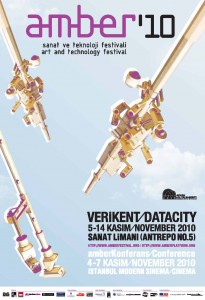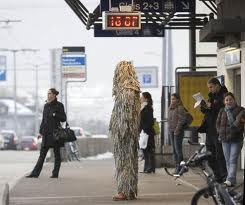 During the 5th and 14th of November, the city of Istanbul became subject and object, host and platform to the fourth international Amber Art and Technology Festival. The festival explores and questions the impact of technologies on social, cultural, and political domains via artistic practices. This year’s theme was: DATACITY. The Mobile City’s guest blogger (and Amber conference-organizer) Zeynep Gündüz reports.
During the 5th and 14th of November, the city of Istanbul became subject and object, host and platform to the fourth international Amber Art and Technology Festival. The festival explores and questions the impact of technologies on social, cultural, and political domains via artistic practices. This year’s theme was: DATACITY. The Mobile City’s guest blogger (and Amber conference-organizer) Zeynep Gündüz reports.
DATACITY conference
DATACITY takes the modern city as a data cluster as a departure point to examine novel experiences and perceptions of the city and its inhabitants. The artworks exhibited in the Amber’10 exhibition explore ‘ways of life’, production and consumption patterns, and politics of the DATACITY. The main exhibition displays art projects of Turkish and international artists; these projects aimed to revisit and rethink how technologies extend and/or modify the experience of the city. (An overview of participating artists and their work can be found here)
A prominent side-event was the Amber conference, which took place on the 6th and 7th of November in the cinema salon of the Istanbul Modern Art Museum. At the conference the meaning of DATACITY was explored from various perspectives.
Horst Hortner, one of the founders of Ars Electronica, for example, presented a new interactive interface –SimLinzMobile- that provides different interaction modalities to generate and visualize views of datasets on statistical and real-time information of a city. (more information on Ars Electronica can be found here)
Keynote speaker CJ Lim, on the other hand, presented the notion of “Smartcity” by which he addressed the issue of‘urban agriculture’ or how the production of food can affect the architecture of an urban city. (More information on the book Smart-cities and Eco-warriors can be found here)
 |
| Set-up for Rhythm of City |
In contrast to most presentations in which the speakers start by introducing the content of the presentation, Varvara Guljajeva and Mar Canet Sola’s presentation started in silence. Instead of the speakers, a metronome was placed on the table. Gradually, the metronome started moving; however, it did not accompany a music instrument. Moreover, the metronome moved in various rhythms: at times it slowed down and at times it moved very fast. What made the metronome move? And what made it change its speed? At this moment, Guljajeva and Canet Sola explain that we have witnessed the art installation “The Rhythm of City”. This project can be described as a digital update of Bornstein and Bornstein’s (1976) study, which showed a positive correlation between the walking speed of pedestrians and the size of the city. In “The Rhythm of City”, Guljajeva and Canet Sola aim to capture the rhythm of a city by extracting geo-tagged social content and translating this data into the rhythm of a physical metronome in real-time. In other words, what made the metronome move and what made it change its speed was the data such as, SMS messages, videos of the inhabitants in certain locations in Istanbul. (A detailed explanation and demo video of this project can be found here)
The last panel of the second day, however, balanced ‘positive’ visions of DATACITY by critically questioning the rapid increase of technologies in everyday life, the difficulty of being anonymous and the impossibility to not be ‘seen’ in contemporary everyday life. Presenters, such as Georg Russeger and Ebru Yetiskin reminded us that data means translation and that translation inevitably leads to selection, exclusion, and loss.
 |
| Knowbotic Research in the MacGhillie suit |
The presentation of Christian Huebler from Knowbotic Research addressed questions of public invisibility and camouflage within a world infiltrated by omnipresent technologies. Huebler made his point clear as he left the room dressed in a MacGhillie suit. As Huebler explains, the so-called MacGhillie suit was invented in the 19th century for hunting and was later also used during the First World War. The MacGhillie’s camouflage effect leads to the anonymisation and neutralisation of the person who wears it in public, and therefore, served the interest of Huebler’s objection to DATACITY. (An elaborate overview of Knowbotic Research can be found here)
More about the festival:
Beside its main exhibition, amber’10 was host to two other exhibitions. The Global Gateway Project, funded by Istanbul 2010 European Capital Of Culture – Civil Society Dialogue Grant Program, and Playful Interface Cultures Exhibition, which is created by the works of Interface Culture Graduate Program, Linz Art and Industrial Design University (more information on Playful Interfaces can be found here)
While the exhibitions allowed the public to visit the artworks, the side events offered a more-in depth engagement with the artists for the audience. The workshops, for example, allowed an intimate and interactive platform for the public to engage with the artists and learn more about the starting point for some of the projects and the features of the technologies used. The event “400 seconds” gave all artists 400 seconds to explain their art projects in front of the public. In this sense, 400 seconds can be framed as a kind of “speed dating” with the artists. Finally, the four performances in “Lunapark”, were the artistic outcome of a research on the impact of technologies on issues such as, personal traces, memory, and the fall and rise of traditions in the DATACITY. The performances were repeated several times per night and the repetitive character of Lunapark allowed the public to experience the performances more than once. (more information on the Lunapark project can be found here)
The Amber’10 Conference was accompanied by a film screening and two workshops: “Data Visualization and GIS for Urban Systems” by Selim Balcisoy and “Locative Contours, Residua and Documentary Inclinations” by Tina Bastajian ve Seda Manavoglu.
Amberfestival ‘10 will publish its catalogue next month. The catalogue will provide an elaborative overview of the main and side events that took place in and around DATACITY. The presentations on the DATACITY offered during the two-day conference will be published in the form of an e-book.

One response to “DATACITY – Report of Amber’ 10 – Art and Technology Festival in Istanbul (November 2010)”
[…] (November 2010), recientemente realizada en Estambul y en el que fue presentada la experiencia Rhythm of City. ¿Qué es Rythm of the City? Es una experiencia en la cual es posible representar a través de un […]